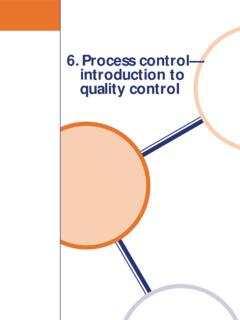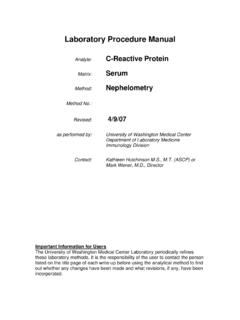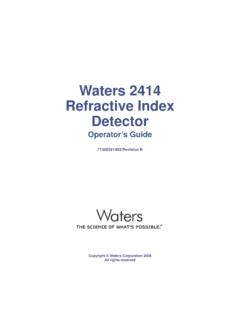Transcription of EP05-A3: Evaluation of Precision of Quantitative ...
1 October 2014EP05-A3 Evaluation of Precision of Quantitative Measurement Procedures; Approved Guideline Third EditionThis document provides guidance for evaluating the Precision performance of Quantitative measurement procedures. It is intended for manufacturers of Quantitative measurement procedures and for laboratories that develop or modify such guideline for global application developed through the Clinical and Laboratory Standards Institute consensus and Laboratory Standards Institute Setting the standard for quality in clinical laboratory testing around the Clinical and Laboratory Standards Institute (CLSI)
2 Is a not-for-profit membership organization that brings together the varied perspectives and expertise of the worldwide laboratory community for the advancement of a common cause: to foster excellence in laboratory medicine by developing and implementing clinical laboratory standards and guidelines that help laboratories fulfill their responsibilities with efficiency, effectiveness, and global applicability. Consensus ProcessConsensus the substantial agreement by materially affected, competent, and interested parties is core to the development of all CLSI documents.
3 It does not always connote unanimous agreement, but does mean that the participants in the development of a consensus document have considered and resolved all relevant objections and accept the resulting agreement. Commenting on DocumentsCLSI documents undergo periodic Evaluation and modification to keep pace with advancements in technologies, procedures, methods, and protocols affecting the laboratory or health s consensus process depends on experts who volunteer to serve as contributing authors and/or as participants in the reviewing and commenting process.
4 At the end of each comment period, the committee that developed the document is obligated to review all comments, respond in writing to all substantive comments, and revise the draft document as appropriate. Comments on published CLSI documents are equally essential, and may be submitted by anyone, at any time, on any document. All comments are addressed according to the consensus process by a committee of experts. Appeals ProcessIf it is believed that an objection has not been adequately addressed, the process for appeals is documented in the CLSI Standards Development Policies and Process comments and responses submitted on draft and published documents are retained on file at CLSI and are available upon request.
5 Get Involved Volunteer!Do you use CLSI documents in your workplace? Do you see room for improvement? Would you like to get involved in the revision process? Or maybe you see a need to develop a new document for an emerging technology? CLSI wants to hear from you. We are always looking for volunteers. By donating your time and talents to improve the standards that affect your own work, you will play an active role in improving public health across the further information on committee participation or to submit comments, contact and Laboratory Standards Institute950 West Valley Road, Suite 2500 Wayne, PA 19087 USA P: : 1-56238-967-X (Print)ISBN 1-56238-968-8 (Electronic)ISSN 1558-6502 (Print)ISSN 2162-2914 (Electronic) EP05-A3 Vol.
6 34 No. 13 Replaces EP05-A2 Vol. 24 No. 25 AbstractClinical and Laboratory Standards Institute document EP05-A3 Evaluation of Precision of Quantitative Measurement Procedures; Approved Guideline Third Edition provides guidance for evaluating the Precision of in vitro diagnostic Quantitative measurement experimental designs and includes recommendations for establishing Precision performance. Included are guidelines for duration, experimental designs, materials, data analysis, summarization, and interpretation techniques adaptable for a wide spectrum of measurands and system complexity.
7 These guidelines are intended for manufacturers or developers of clinical laboratory measurement procedures, and for users who wish to determine their own performance characteristics. A balance is created in the document between complexity of design and analysis, and simplicity of operation. Clinical and Laboratory Standards Institute (CLSI). Evaluation of Precision of Quantitative Measurement Procedures; Approved Guideline Third Edition. CLSI document EP05-A3 (ISBN 1-56238-967-X [Print]; ISBN 1-56238-968-8 [Electronic]). Clinical and Laboratory Standards Institute, 950 West Valley Road, Suite 2500, Wayne, Pennsylvania 19087 USA, 34 Number 13 Evaluation of Precision of Quantitative Measurement Procedures; Approved Guideline Third EditionRobert J.
8 McEnroe, PhDA. Paul DurhamMarc D. GoldfordMarina V. Kondratovich, PhDSamir Lababidi, PhDRobert Magari, PhDJonathan Guy Middle, PhDJames F. Pierson-PerryJeffrey E. Vaks, PhDThe Clinical and Laboratory Standards Institute consensus process, which is the mechanism for moving a document through two or more levels of review by the health care community, is an ongoing process. Users should expect revised editions of any given document. Because rapid changes in technology may affect the procedures, methods, and protocols in a standard or guideline, users should replace outdated editions with the current editions of CLSI documents.
9 Current editions are listed in the CLSI catalog and posted on our website at If you or your organization is not a member and would like to become one, and to request a copy of the catalog, contact us at:P: F: E: W: 13EP05-A3 Copyright 2014 Clinical and Laboratory Standards Institute. Except as stated below, any reproduction of content from a CLSI copyrighted standard, guideline, companion product, or other material requires express written consent from CLSI. All rights reserved. Interested parties may send permission requests to CLSI hereby grants permission to each individual member or purchaser to make a single reproduction of this publication for use in its laboratory procedure manual at a single site.
10 To request permission to use this publication in any other manner, e-mail Suggested CitationCLSI. Evaluation of Precision of Quantitative Measurement Procedures; Approved Guideline Third Edition. CLSI document EP05-A3. Wayne, PA: Clinical and Laboratory Standards Institute; GuidelineDecember 1981 Tentative GuidelineDecember 1982 Approved GuidelineFebruary 1999 Approved Guideline Second EditionAugust 2004 Approved Guideline Third EditionOctober 2014*ISBN 1-56238-967-X (Print)ISBN 1-56238-968-8 (Electronic)ISSN 1558-6502 (Print)ISSN 2162-2914 (Electronic) * EP05-A3 was initially released in September 2014.









